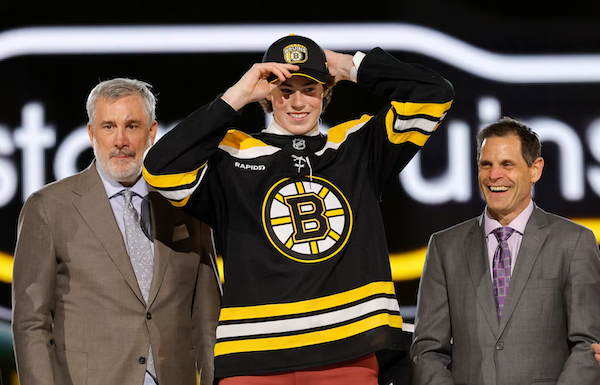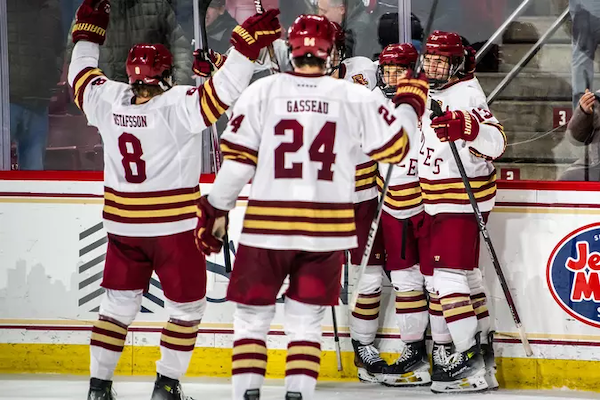
By: Eamonn McLean | Follow me on Twitter/X @EamonnMcLean44
When the Boston Bruins chose Dean Letourneau in this summer’s National Hockey League Entry Draft, they knew he would need some time to develop. How much time will become more apparent this coming fall when he enters his freshman season with the Boston College Eagles.
After producing 127 points in 56 games in Canadian Prep School, the Braeside, Ontario native jumps to the Collegiate level. Letourneau joins an Eagles team that won the Hockey East Championship last season before falling in the National Championship to the Denver Pioneers, finishing 34-6-1.
The Eagles look poised for another long run in the NCAA Tournament this season. BC returns seven of its ten leading scorers from last year, including Bruins Prospects Andre Gasseau and Oskar Jellvik.

Limited by injury, Letourneau heads to college with only two junior hockey games under his belt, an unusual development path for most NHL prospects. Usually, players spend one or two seasons in a junior league before heading to the NCAA. Let’s look at some players who took similar paths to see what might be expected.
In the 2018 NHL Draft, the Philadelphia Flyers selected Jay O’Brien from Thayer Academy. Having only played five games across two seasons in the United States Hockey League, O’Brien immediately suited up for the Providence Friars the following season, but it didn’t go as hoped. After scoring only five points in 25 games as a freshman, O’Brien decided to return to junior hockey for another year.
The former first-round pick finished his collegiate career at Boston University, where he scored 70 points in 79 games before graduating in 2023. However, the Flyers declined to sign O’Brien, making him an Unrestricted Free Agent. Instead, O’Brien signed with the Toronto Marlies but did not play a single game due to injury. Now healthy, he will play for the American Hockey League’s Charlotte Checkers this season.
A second example with a more positive outcome is Mark Jankowski. In 2012, the Calgary Flames used the 21st pick to draft Jankowski straight out of Stanstead College, another Canadian High School. Like O’Brien, Jankowski began his college career with the Friars. But unlike O’Brien, Jankowski had a solid freshman season, scoring 18 points in 34 games. He then improved in each of his college seasons and won the National Championship in 2015. Jankowski has gone on to a successful NHL career and is currently a member of the Nashville Predators.
So, is Letourneau another O’Brien, another Jankowski, or something else? His future is unknown, but he has several things working in his favor, the most obvious of which is his size. At 6′-7″, 214 pounds, Letourneau is well suited to deal with the increase in physicality that comes with playing against college players.
Letourneau’s skating and shooting skills are also strong, attributes that enabled him to score 61 goals last season and which should translate to the college level. Finally, and most importantly, when he arrives on Commonwealth Avenue this fall, he will join a team poised to compete for a National Championship.
Dean will be surrounded by quality talent, as Boston College has twelve NHL draft picks on its roster. All the ingredients are there for a potential breakout season—can Letourneau take advantage? Bruins scouts will be regular attendees in Chestnut Hill this season, watching closely, just like the rest of us.
Dean Letourneau’s development is one to watch closely for Bruins fans. Likewise, players looking for flexibility in gaming might explore casinos without Norwegian license, offering access to international gaming options.


Leave a Reply